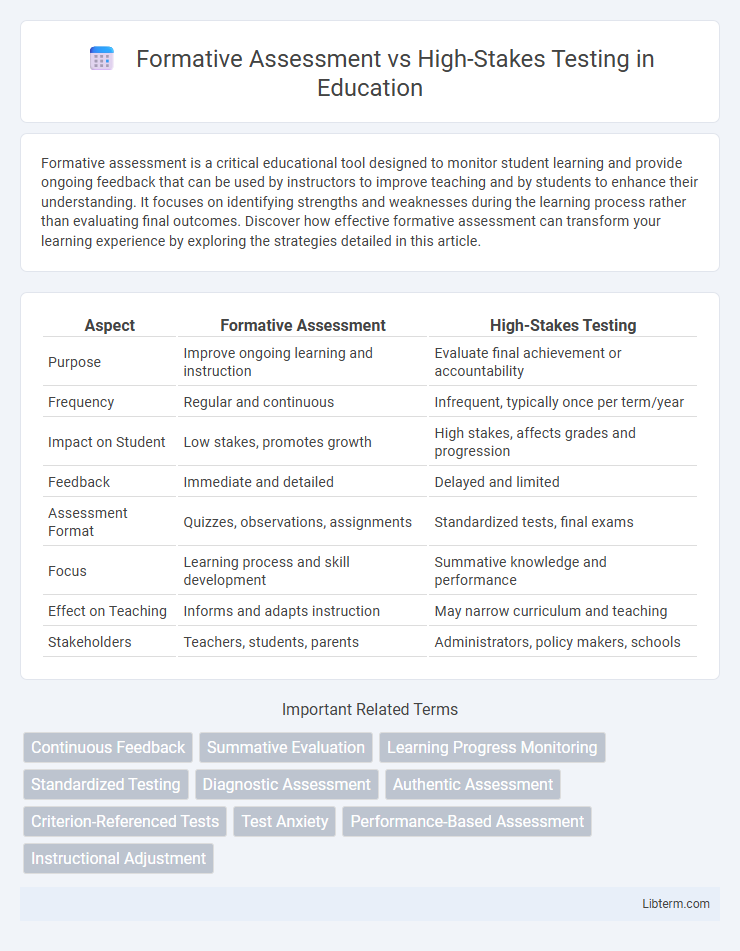Formative assessment is a critical educational tool designed to monitor student learning and provide ongoing feedback that can be used by instructors to improve teaching and by students to enhance their understanding. It focuses on identifying strengths and weaknesses during the learning process rather than evaluating final outcomes. Discover how effective formative assessment can transform your learning experience by exploring the strategies detailed in this article.
Table of Comparison
| Aspect | Formative Assessment | High-Stakes Testing |
|---|---|---|
| Purpose | Improve ongoing learning and instruction | Evaluate final achievement or accountability |
| Frequency | Regular and continuous | Infrequent, typically once per term/year |
| Impact on Student | Low stakes, promotes growth | High stakes, affects grades and progression |
| Feedback | Immediate and detailed | Delayed and limited |
| Assessment Format | Quizzes, observations, assignments | Standardized tests, final exams |
| Focus | Learning process and skill development | Summative knowledge and performance |
| Effect on Teaching | Informs and adapts instruction | May narrow curriculum and teaching |
| Stakeholders | Teachers, students, parents | Administrators, policy makers, schools |
Understanding Formative Assessment
Formative assessment is an ongoing process that provides real-time feedback to both students and educators, helping identify learning gaps and tailor instruction to improve student outcomes. Unlike high-stakes testing, which evaluates cumulative knowledge at a single point, formative assessment emphasizes continuous progress monitoring through quizzes, observations, and interactive activities. This approach fosters a deeper understanding of subject matter by encouraging active engagement and timely intervention before final evaluations.
Defining High-Stakes Testing
High-stakes testing refers to standardized exams designed to make significant decisions about a student's academic future, such as grade promotion, graduation eligibility, or college admission. These tests often determine school funding or educator evaluations, carrying significant consequences beyond mere assessment. Unlike formative assessment, high-stakes testing emphasizes summative evaluation with limited feedback opportunities for continuous learning improvement.
Core Objectives of Each Assessment Type
Formative assessment primarily aims to monitor student learning and provide ongoing feedback to improve instructional strategies and student performance, emphasizing skill development and comprehension. High-stakes testing focuses on evaluating cumulative knowledge and performance at critical decision points, such as grade promotion, graduation, or accountability measures, prioritizing standardized criteria and comparability. Both assessments serve distinct purposes: formative assessment supports learning processes while high-stakes testing measures achievement outcomes.
Key Differences Between Formative and High-Stakes Testing
Formative assessment involves ongoing feedback during the learning process, aiming to improve student understanding and instructional strategies, while high-stakes testing typically evaluates cumulative knowledge at the end of a course or term with significant consequences for students or educators. Formative assessments are low-pressure, frequently administered, and adaptable to individual learning needs, whereas high-stakes tests are standardized, infrequent, and often linked to graduation, advancement, or funding decisions. The key difference lies in purpose and impact: formative assessments support learning and growth, whereas high-stakes tests measure achievement and accountability.
Impact on Student Learning and Motivation
Formative assessment enhances student learning by providing continuous feedback that identifies strengths and areas for improvement, fostering a growth mindset and intrinsic motivation. High-stakes testing often generates anxiety and narrows curriculum focus, potentially undermining student engagement and authentic understanding. Research indicates that formative assessment practices lead to higher achievement and sustained motivation compared to the pressure-driven environment of high-stakes exams.
Role of Teachers in Both Assessment Methods
Teachers play a pivotal role in formative assessment by continuously monitoring student progress, providing real-time feedback, and adapting instruction to meet individual learning needs. In high-stakes testing, educators are responsible for preparing students to perform well on standardized exams that significantly impact academic advancement and accountability measures. The effectiveness of both assessment methods depends heavily on teachers' ability to balance instructional strategies that foster learning growth and ensure compliance with testing requirements.
Advantages of Formative Assessment
Formative assessment offers continuous feedback that enhances student learning by identifying strengths and weaknesses in real time, allowing for timely instructional adjustments. It supports personalized learning paths and encourages student engagement through low-pressure, interactive assessments. Unlike high-stakes testing, formative assessment reduces test anxiety and promotes deeper understanding and skill development over time.
Limitations of High-Stakes Testing
High-stakes testing often suffers from limitations such as narrowed curriculum focus, teaching to the test, and increased student anxiety, which can undermine genuine learning. These exams may not accurately reflect a student's comprehensive abilities or critical thinking skills, leading to potential misjudgments in educational outcomes. The pressure associated with high-stakes assessments can also disproportionately disadvantage students from marginalized backgrounds, exacerbating educational inequities.
Integrating Assessment for Holistic Education
Integrating formative assessment with high-stakes testing fosters a holistic education by balancing ongoing feedback and summative evaluation. Formative assessment provides real-time insights into student learning processes, enabling personalized instruction and skill development, while high-stakes testing offers standardized benchmarks for accountability and curriculum alignment. Combining these approaches supports comprehensive student growth, emphasizing both mastery of content and critical thinking abilities.
Future Trends in Student Assessment Practices
Future trends in student assessment practices emphasize a shift from high-stakes testing towards formative assessments that provide continuous, real-time feedback to enhance learning outcomes. Advances in educational technology enable adaptive assessments that personalize learning experiences and support diverse student needs. Data analytics and artificial intelligence integration are set to refine predictive capabilities, making assessments more dynamic and reflective of individual growth over time.
Formative Assessment Infographic

 libterm.com
libterm.com